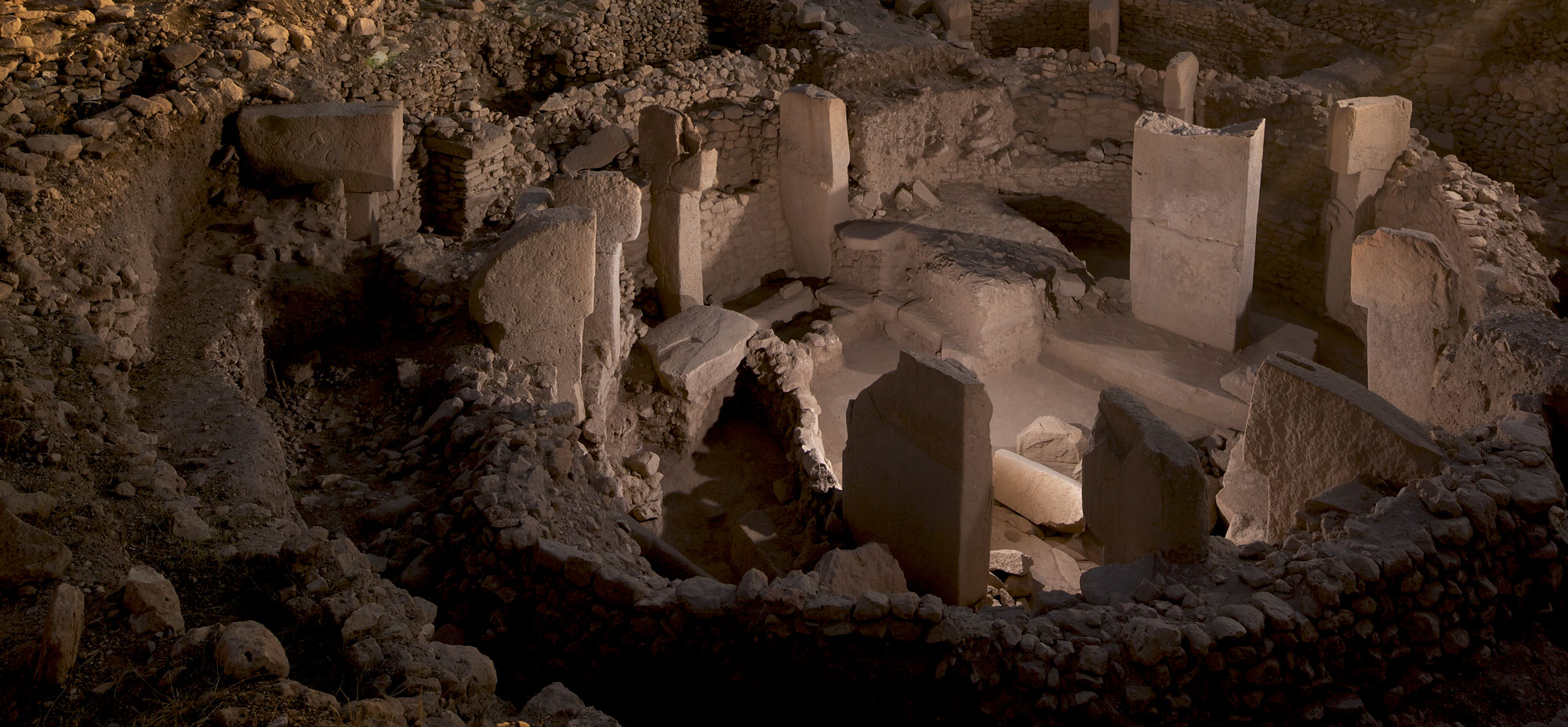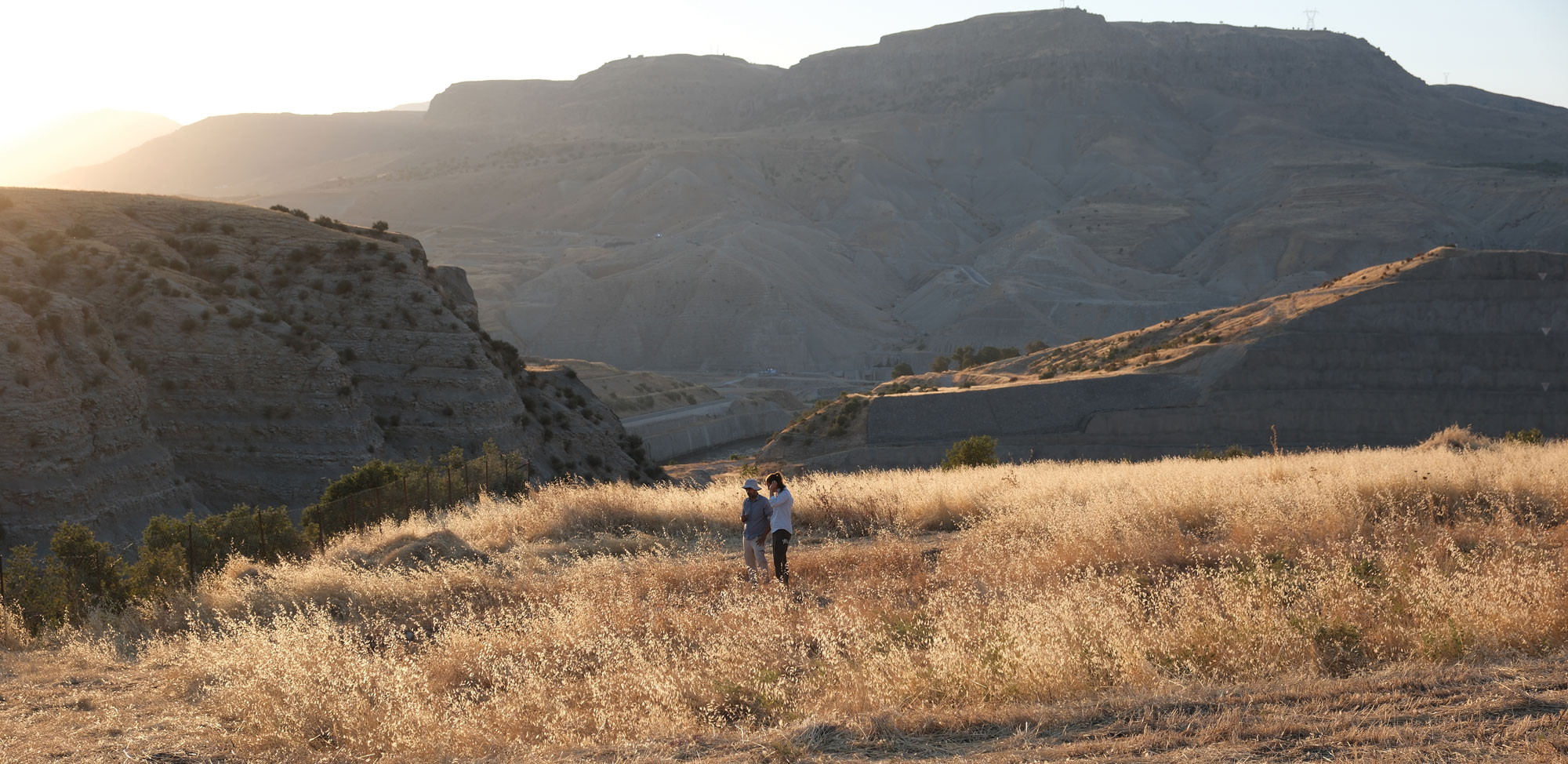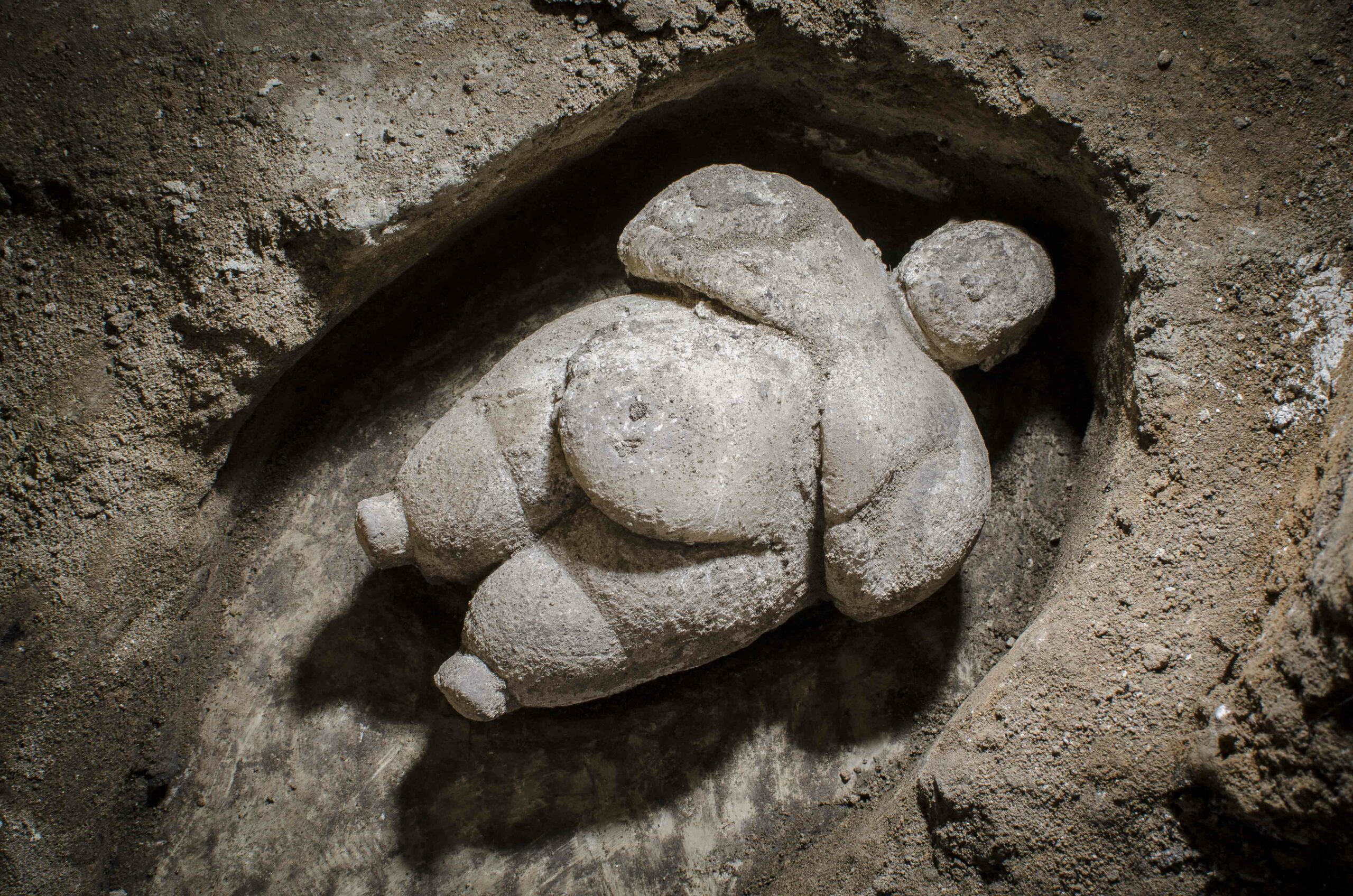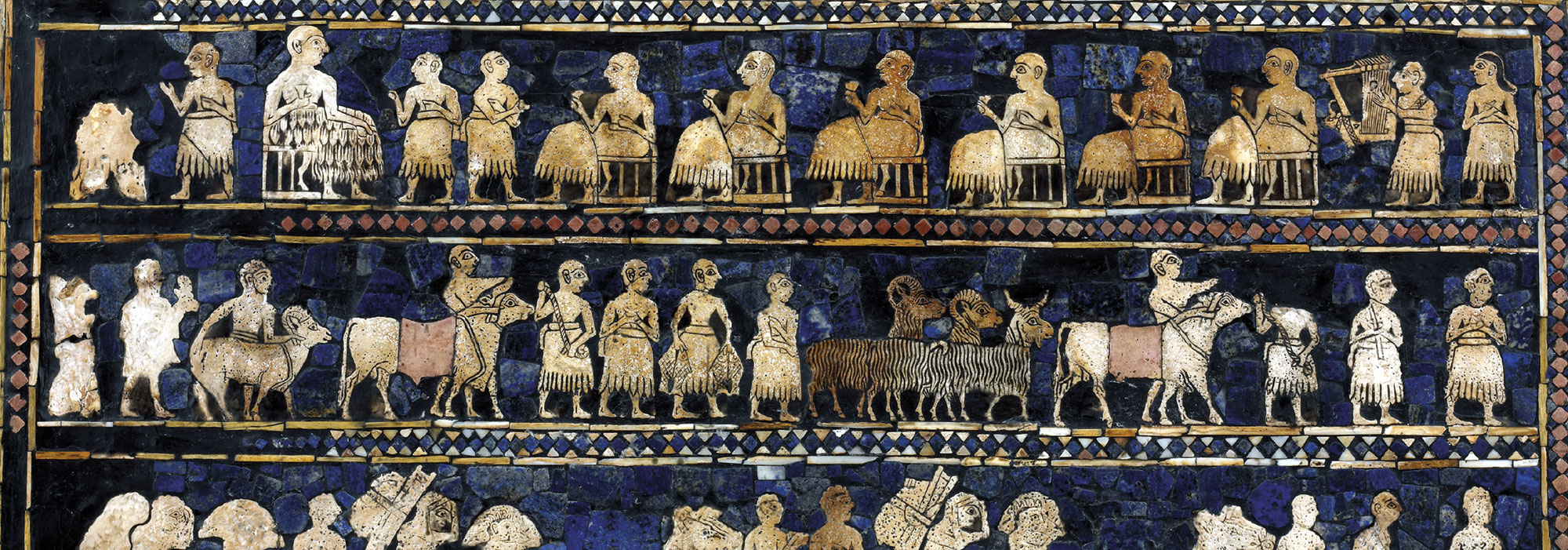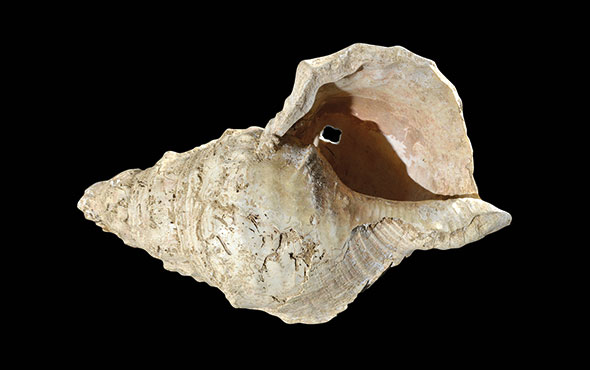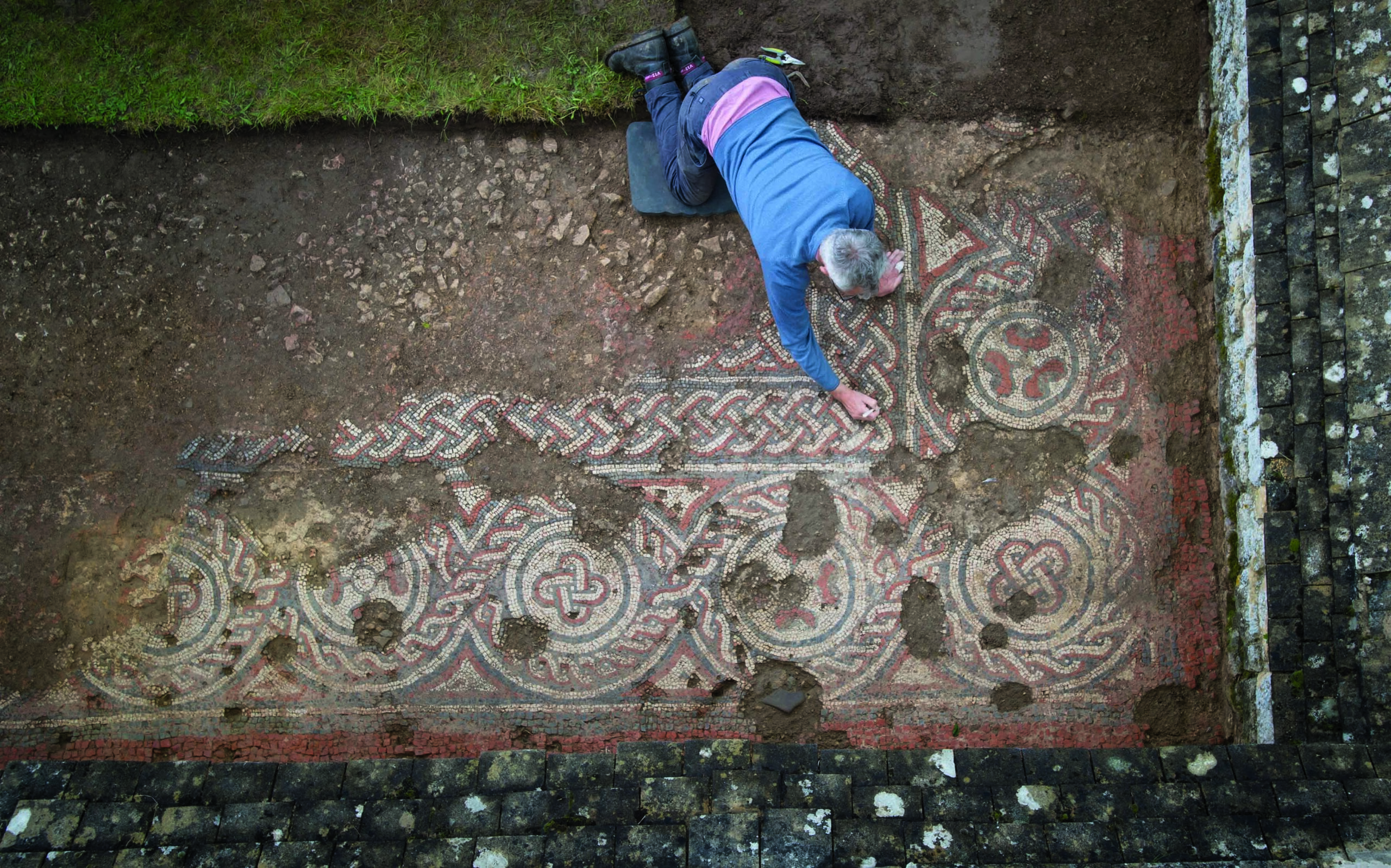
More than 20 light-colored limestone structures climb the hill of Göbekli Tepe, a 45-foot-high rise on a rolling plateau in southeastern Turkey. Some of these structures are round or oval spaces enclosed by sturdy walls. Many of them have large T-shaped pillars standing just off-center in the middle and around the edges, incorporated into the walls or into raised stone benches. On a clear, sunny day, the stones are a uniform, dusty brown. At night, when not artificially lit, they disappear into the landscape.

The smallest of the buildings is 20 feet across, with pillars rising to about 10 feet high, while the largest circle, which archaeologists call simply Building D, measures no less than 65 feet across. Building D is punctuated by two 18-foot-tall freestanding limestone central pillars, each weighing an estimated eight tons. The pedestals they rest on are carved directly from the bedrock, as if rising out of the earth. From a distance, the pillars have an abstract appearance, a combination of straight lines and gentle curves. But, moving closer to them, it soon becomes clear that the pillars aren’t simply geometric shapes, but stylized depictions of people. Standing inside the circles, it’s possible to make out finely carved reliefs decorating the massive stones—arms and folded hands, along with fox pelts hung from simple belts to form loincloths.
Eleven smaller T-pillars form a circle around the central standing figures in Building D. They too are decorated, with carvings featuring a menagerie of crawling, flying, and running wild beasts. Snakes, birds, and foxes dominate the array, but the predators among them are accompanied by gazelles, ducks, and aurochs. Right next to this circular structure is another, with smaller T-pillars at its center and carvings dominated by depictions of snakes. Foxes slink across the pillars of yet another circle just a few feet away. Other motifs mix with the animals—circles, mesh nets, phalluses, and what appear to be disembodied human heads.
When archaeologists first began excavating on this Turkish hilltop 25 years ago, Building D and the other structures they discovered struck them as unusual, perhaps even unique. By comparing the tools found scattered amid the site’s rubble to similar artifacts known from other sites, researchers determined that the largest circles were at least 11,000 years old—and perhaps even older. This made them the earliest known monumental structures built by human hands.
In 2006, after a decade of work at Göbekli Tepe, a team led by German Archaeological Institute (DAI) archaeologist Klaus Schmidt reached a stunning conclusion: The buildings and their multiton pillars, along with smaller, rectangular structures higher on the slope of the hill, were monumental communal buildings erected by people at a time before they had established permanent settlements, engaged in agriculture, or bred domesticated animals. Schmidt did not believe that anyone had ever lived at the site. He suggested that, in the Neolithic period between 9500 and 8200 B.C., bands of nomads had come together regularly to set up stone circles and carve pillars, and then deliberately covered them up with the rocks, gravel, and other rubble he found filling in the various enclosures. Schmidt posited that both the construction and abandonment of what he called “special enclosures” had been accompanied by great feasts of local game washed down with beer brewed from wild grasses and grains. Those who gathered for these periodic monumental building projects scattered before coming back decades or centuries later to do it all again. He called Göbekli Tepe “a cathedral on a hill,” and imagined it might have been a place where hunter-gatherers bid farewell to their dead or staged ceremonies to emphasize their shared identity.
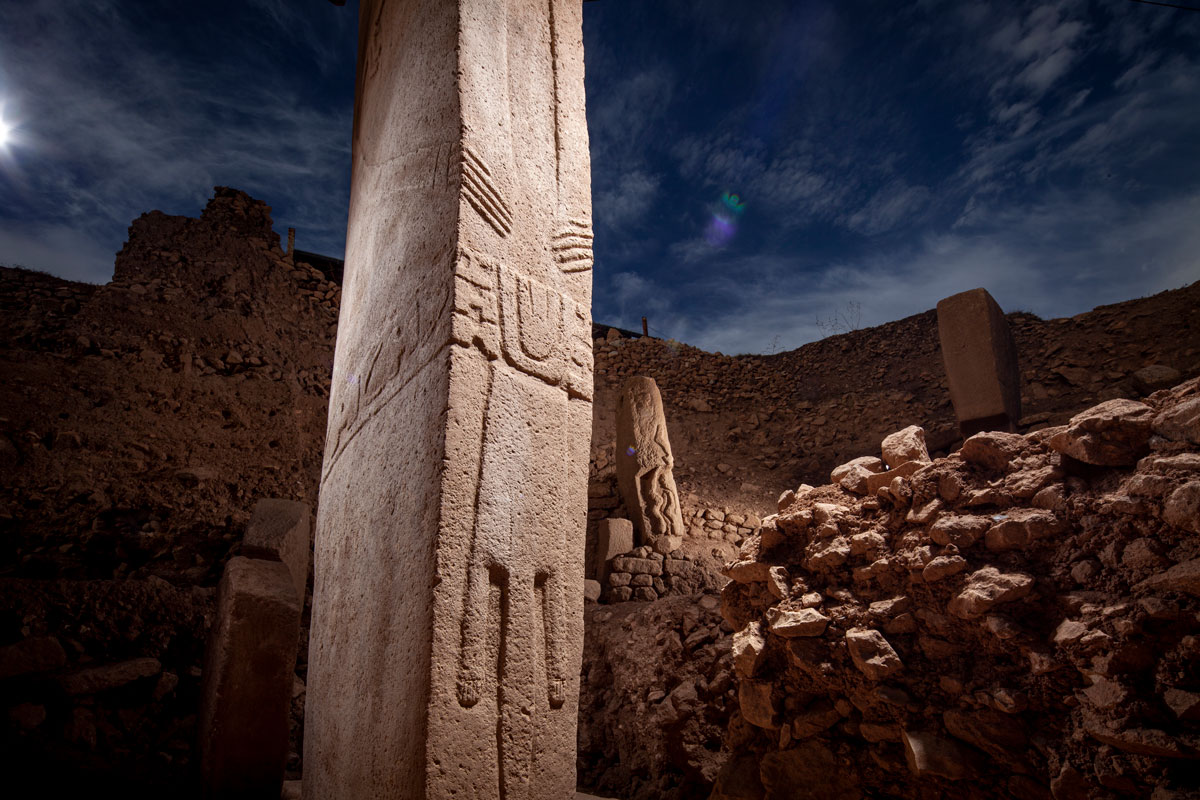
The discovery of Göbekli Tepe promised to change the way scholars understood the Neolithic period. Around the time the earliest stone pillars were being carved, people were beginning to settle down and grow crops in an area stretching from modern-day Israel north to Turkey and east to Iraq. Though modest at first, the advent of farming and settlement paved the way for the development of complex civilizations and the way most of the world lives today. Archaeologists long agreed that only after adopting all the elements of the so-called Neolithic package, including permanent settlements and plant and animal domestication, could societies progress to what they saw as the luxury of creating social hierarchies, constructing monumental buildings, and carrying out complex rituals. The move toward the stratified civilizations of the present could only have begun, the argument went, once people had a surplus of food and a fixed address to call home.
The first finds at Göbekli Tepe soon threw that time line into question. Reinforced by radiocarbon dates taken from bones found amid the rubble, the dates of the stone tools at the site placed its construction firmly at the beginning of the Neolithic period, around 9000 B.C., centuries before the first domesticated grains appeared at settlements in the area. Some of the first evidence of domesticated grain in both the region and the world comes from a site called Nevalı Çori, a few dozen miles to the west of Göbekli Tepe. Founded in 8400 B.C. and abandoned a few centuries later, Nevalı Çori overlaps only with the very latest occupation of Göbekli Tepe.
Schmidt thought this demonstrated that complex social organization and the performance of rituals actually predated permanent settlement and agriculture, and that the people who banded together and built the monumental structures were nomadic hunter-gatherers. He suggested that, eventually, the demands of gathering these nomads together in one place to carve and move the huge T-pillars and build the circular enclosures pushed them to take the next step and begin domesticating plants and animals in order to create a more dependable food supply. These innovations, he argued, spread from the hilltop throughout the region and eventually the globe. Ritual and religion, it seemed, launched the Neolithic Revolution, not the other way around. “First the temple, then the city” was how Schmidt summed it up.
However, new discoveries at Göbekli Tepe and a close examination of the results from the earlier excavations are upending things once again. Archaeologists have uncovered evidence that the site was a settlement after all, and that many of its large ritual structures were used contemporaneously, not built one after another over the course of centuries. At the same time, a growing group of scholars, including the DAI’s Lee Clare, who took over excavations at the site after Schmidt’s death in 2014, argue that Göbekli Tepe’s towering anthropomorphic pillars and powerful animal carvings do not mark the beginning of the Neolithic period. Instead, they contend, the entire site represents a last-ditch attempt to hold onto a vanishing way of life. The people of Göbekli Tepe weren’t driving the Neolithic Revolution forward—they were shoving back against it as hard as they could.
Did Göbekli Tepe start as a hunter-gatherer meeting place and end up as a Neolithic village? Or were its T-pillars defiant monuments to a hunter-gatherer tradition that stretched back thousands of years to the Ice Age? “That,” says Austrian Academy of Sciences archaeologist Barbara Horejs, “is the billion-dollar question.”
When they were first uncovered, the dozens of structures at Göbekli Tepe were filled with rocks, soil, and tens of thousands of wild animal bones. That suggested to Schmidt that the buildings represented a series of sanctuaries or temples built over the course of nearly 1,500 years, one after another. After a century or so of use, he argued, the circles and their pillars were ritually buried, and new structures were sometimes built on top. The animal bones found in the rubble were, he thought, remains of feasts staged to attract workers to the hilltop for periodic building parties, the prehistoric equivalent of barn raisings. Over time, this repeated backfilling and rebuilding created the rounded mound that gives Göbekli Tepe its name, which is loosely translated from Turkish as “Potbelly Hill.” “Klaus’ big statement was this wasn’t a settlement at all, but a ritual site for surrounding communities,” says Douglas Baird, an archaeologist at the University of Liverpool.
EXPAND
Tools of the Trade
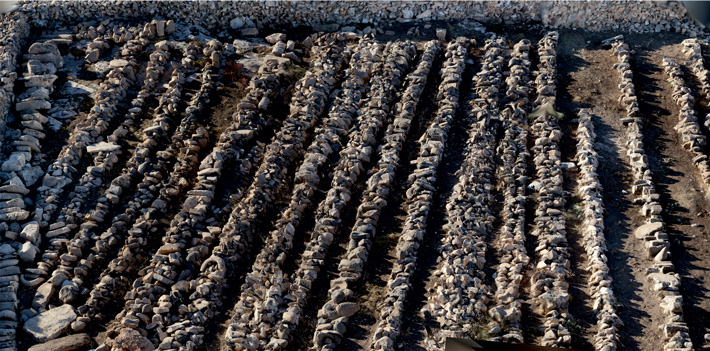
In 2016, German Archaeological Institute archaeologist Laura Dietrich began analyzing thousands of stone grinding tools that had been excavated at Göbekli Tepe over the course of nearly two decades. The tools (left), along with hundreds of stone vessels (above), had mostly been ignored by researchers. Using a combination of use-wear studies, experimental archaeology, and microscopy, Dietrich analyzed the way in which the stones had been worn down over time and showed that they had been used to process grains and legumes. She identified chemical residues on many of the vessels that provided evidence they had been used to cook vats of porridge or perhaps the occasional batch of prehistoric beer. “Most probably,” Dietrich says, “these people were cultivators, or at least had strategies to gather large quantities of wild grain.”
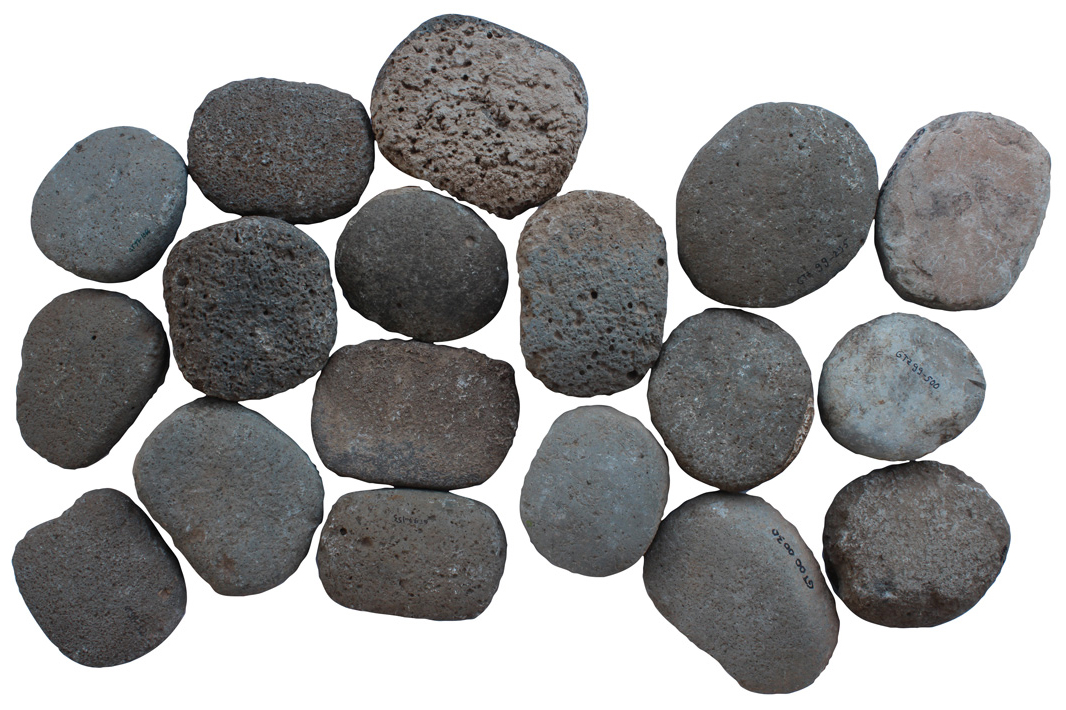
That interpretation supported the theory that Göbekli Tepe was built by hunter-gatherers, not settled farmers. But when DAI archaeologist Moritz Kinzel first began examining old excavation reports in 2017, he questioned whether the ritual structures had been built sequentially. Originally trained as an architect, Kinzel found the idea that the rubble filling the monumental buildings had been shoveled in all at once by the site’s builders and topped with the remains of feasts puzzling. “There are a lot of features in the ruins that are strange if the buildings were backfilled,” Kinzel says. For example, if the structures had been filled in all at once, the damage to the walls would be consistent all the way around. Instead, the walls closest to the slope of the hill are in the worst condition. “They show clear signs of slope slide or pressure,” explains Kinzel. “The walls farthest away from the slope are much better preserved.”
And there is further evidence that undercuts the idea that the temples were deliberately filled in and then abandoned. The construction of a swooping roof canopy made of steel and fabric over the site in 2017 gave Kinzel and Clare the opportunity to reexamine a few spots where the roof’s support pillars were to be placed. “It was like keyhole surgery, going straight down through the deposits,” Clare says. “We had a good chance to look at the site’s deepest layers and lowest deposits.” These new excavations offered a way to investigate whether people were living at Göbekli Tepe from the start, or whether it slowly evolved from an isolated religious center to a village. “In deep soundings, we went right down to the natural levels of the mound,” says Clare. “We found middens, fireplaces, hearths, lithics—all smelling very domestic. For me, there was domestic activity from the beginning right to the very end.”
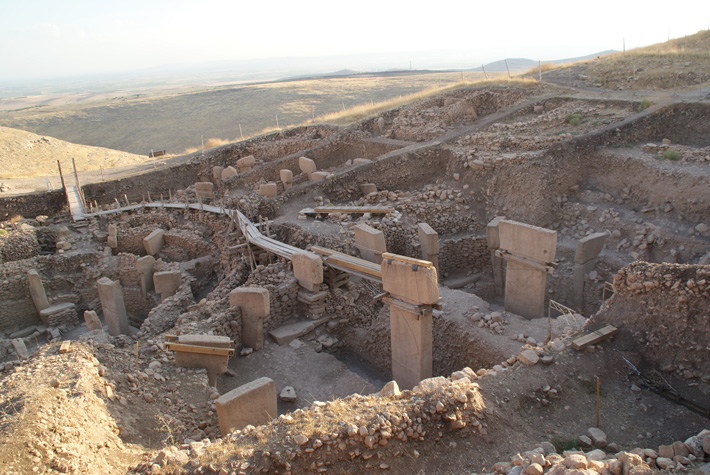
Having dug down until they reached bedrock, Kinzel and Clare noticed that several of the largest buildings had been repaired or rebuilt multiple times. Furthermore, many of the central T-pillars leaned in the same direction, as though knocked off balance by the same event. Kinzel and Clare now think that instead of having been filled intentionally, the circular buildings were instead rocked by earthquakes or buried by landslides over the centuries, and then renovated or reerected over and over again. “Suddenly, we realized that maybe the monumental buildings had a much longer use life than we had thought,” Kinzel says. Clare explains that he now believes that much of the fill is simply debris created by collapsing buildings. “All these bones which were interpreted as feasting deposits are actually the remains of previous phases that slipped in,” he says. New radiocarbon dates obtained from a sampling of the animal bones, meanwhile, suggest that the buildings higher on the hillside were probably in use at the same time as the enclosures farther down the slope.
During the recent excavations, the team recovered organic material, including charred wood and plant remains, along with phytoliths, or mineral residues of plants. This evidence could tell them what was growing and what people were cooking at the site more than 10,000 years ago. Laura Dietrich, a DAI archaeologist, also went back to examine thousands of grindstones, mortars, and carved stone vessels that had been excavated at the site over the years and then ignored. These include vessels large enough to make 43 gallons of beer or porridge. The evidence pointed to large-scale food processing for both special occasions and daily life. “We got an idea of normal household assemblages that actually were not special at all,” Kinzel says. This was yet another indication that Göbekli Tepe was home as well as church.
Another major discovery the team made was a pit 25 feet across and almost eight feet deep carved from the bedrock that could have served as a cistern for people living on the hilltop. Some 150 yards from the main building area, they found a carved channel in the bedrock that they identified as a type of early plumbing likely used for collecting rainwater. “They were harvesting water,” Clare says. “That’s a good indication of domestic settlement.”
What Schmidt thought were smaller rectangular ritual structures built later in the site’s history were actually domestic buildings that existed alongside the large round and oval buildings. The team suspects that the structures would have been covered with flat roofs, with entrances on top, like other houses from the ninth millennium B.C. in Syria and Turkey. Debris inside the houses suggests people were working and eating on the roof, or on an upper floor, which eventually collapsed, leaving grindstones, charred wood from fireplaces, and tools mixed in with the rubble below. Clare, Kinzel, and other members of the team think that Göbekli Tepe was probably a village with large circular buildings in a natural dip at the base of the hillside. Smaller, rectangular houses climbed the slope all around them. “I see this not as a site for cults and death but as a full settlement,” Kinzel says. “There’s a relationship between the special enclosures and daily life. It really tells a much richer story than before.”
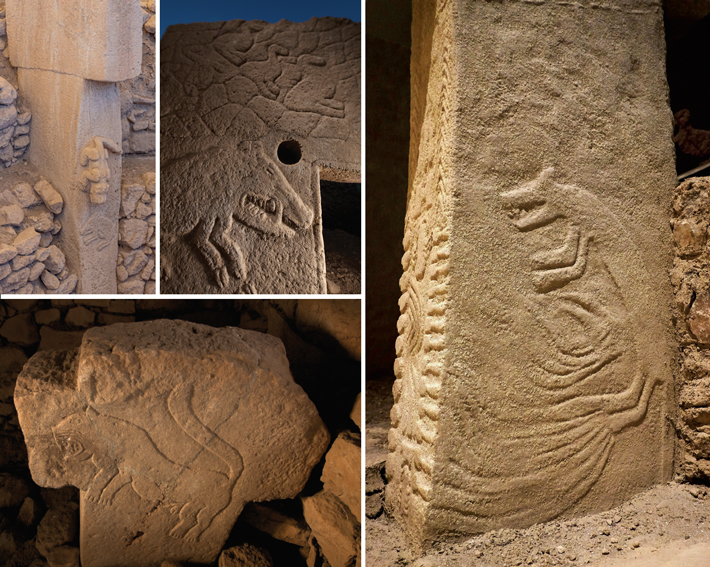
The original discovery of Göbekli Tepe prompted other archaeologists to reexamine previously excavated settlements and to search out new ones in hilly areas nearby. A survey conducted by archaeologist Bahattin Çelik of Iğdır University, for example, found at least a dozen sites with similar round buildings, T-pillars, and animal carvings. And ongoing excavations at a site called Karahan Tepe about 30 miles southeast of Göbekli Tepe suggest Göbekli Tepe might not even contain the oldest monumental T-pillar architecture. Göbekli Tepe now appears as if it may actually be a particularly well-preserved example of a widespread cultural phenomenon. The other sites “are homogenous, even when you look at the ritual buildings,” says Istanbul University archaeologist Mehmet Özdoğan. “They’re subterranean, and they all have pillars. It’s standard, like the plan of a church or mosque.”
Göbekli Tepe was constructed in a region and at a time when people were gradually adopting an entirely new way of life. The dates of the larger circular enclosures at Göbekli Tepe coincide with these first stirrings of change. By the time the site was abandoned for good in 8200 B.C., the Neolithic period was in full swing. But the new evidence suggests the site didn’t play the crucial role in the Neolithic Revolution that scholars once thought. “I don’t agree with the idea of Göbekli Tepe as the smoking gun of the Neolithic,” Clare says. Rather than representing the inspiration for agriculture and settlement in this region, he claims, Göbekli Tepe’s communal structures were built as the last stand of the region’s hunter-gatherers. Instead of embracing the changing lifestyles they witnessed in the flatlands to the south, east, and west, Göbekli Tepe’s builders pushed back.
Unlike later Neolithic sites, which feature carvings of domesticated animals, such as bulls, and female animals, as well as possibly fertility-related imagery, the carvings at Göbekli Tepe depict species that seem different—wilder, and somehow more dangerous. Threatening creatures feature prominently, from scorpions and spiders to vipers and vultures. The mixture of animals, phallic and other symbols, and pillars resembling humans does not appear to be random or merely decorative. Some pillars, such as the one that combines a vulture, a fox, and a severed human head, seem to tell a story. “If you look at the symbolism and depictions carved on the pillars, they’re set up as narratives,” Clare says. “These aren’t just animals one sees every day.”

And while Schmidt thought worshippers may have gathered around the T-pillars under open skies, Kinzel and other researchers now think the circular buildings were covered. They base this conclusion on markings on top of the pillars that indicate that they could have supported or anchored roofs. For Thomas Zimmermann, an archaeologist at Bilkent University, these spaces had a very particular character that reflected a male-centric view dominant in hunter-gatherer society. He imagines them as dark and gloomy, with flickering firelight illuminating the carved T-pillars looming over men gathered inside. “It’s all male, male, male. It’s a theater of horror filled with abrasive male animals ready to attack,” Zimmermann says. “It represents a staunch, conservative, male-dominated hunter-gatherer culture.” In this telling, there’s a reason there are no signs of domesticated grains or tools typical of the Neolithic period at Göbekli Tepe—according to Zimmermann and Clare, they were forbidden. The threatening imagery was intended to keep Göbekli Tepe’s residents in line. “Narratives are very important in keeping groups together and creating identity,” Clare says. “This is about the promotion of a group identity in the face of advancing Neolithization.”

Read this way, the evidence suggests it worked, at least for a while. Perhaps the settled hunter-gatherers at Göbekli Tepe relied exclusively on wild grasses and plentiful game from the fertile plains that stretched out below their perch, the way their ancestors had. As communities across the region were adopting new lifestyles and technologies, the people at Göbekli Tepe were “looking back and placing the emphasis on what had been, not what was going to be,” Clare says. Many scholars suggest there may have been good reasons for them to resist; across the world, the introduction of farming and sedentary life also introduced overcrowding, more disease, and worse nutrition to the human experience.
Ultimately, though, the shifting world proved too much to withstand. Around 8200 B.C., occupation at Göbekli Tepe completely stopped. There is no evidence that people there slowly adopted domesticated grains or began herding goats and sheep. “All of the art and narratives are there to emphasize this dying hunter-gatherer tradition,” Clare says. “Then it collapsed. That explains why the people there don’t trickle out—they just disappear.”
If Clare and Zimmermann are correct, Göbekli Tepe isn’t the beginning of cities and farming, but the final fight of Ice Age hunters unwilling to accept the changes they saw all around them. “It’s not the beginning of the Neolithic, it’s the end of hunter-gatherers,” Zimmermann says. “The idea of a zero point, or beginning of something—the beginning of agriculture, the beginning of sedentary life, the beginning of religion—we have to abandon it.”

This interpretation is controversial, not least because millennia separate the ideas and worldview of the people who carved the images at Göbekli Tepe and scholars’ modern sensibilities and imaginations. “It’s impossible to understand 12,000-year-old symbols in such a direct way,” says Horejs. For his part, Özdoğan suggests the fierce animal carvings might have been intended to symbolically protect the sanctuaries, not to terrorize celebrants. And although the plant remains suggest crop domestication wasn’t part of the Göbekli Tepe toolkit, grain was clearly an element in their lifestyle and diet. Dietrich has analyzed more than 8,000 grinding tools from the site. She believes their sheer number and their refined, standardized shapes suggest a community of proto-farmers already familiar with the cooking possibilities grain offered. “They’re beyond experimentation,” she says. “Most probably they were cultivators.” Previous research at other sites has shown that it takes centuries of purposeful planting and breeding to reshape wild grains into recognizably domestic varieties. Thus the absence of remains of domestic grain at Göbekli Tepe isn’t conclusive proof that people there weren’t planting crops.
Was Göbekli Tepe a Neolithic site or not? Horejs says that may be the wrong question to ask. “Sociocultural processes like this aren’t either-or—they’re continuous,” she says. “Hunter-gatherer life doesn’t stop immediately because people start cultivating grain.” Those living at Göbekli Tepe may have adopted parts of the Neolithic package while preserving elements of their hunter-gatherer past. Maybe they built houses, but left them regularly to chase the area’s plentiful gazelles.
Only about 10 percent of the site has been excavated thus far, and because these excavations have focused on the T-pillars and monumental buildings, future discoveries may compel further reevaluations. Until then, the monuments of Göbekli Tepe should serve as a reminder that our distant ancestors were, perhaps, not so different from us after all. They, too, were complex, communal, often contradictory, and capable of building great things.


